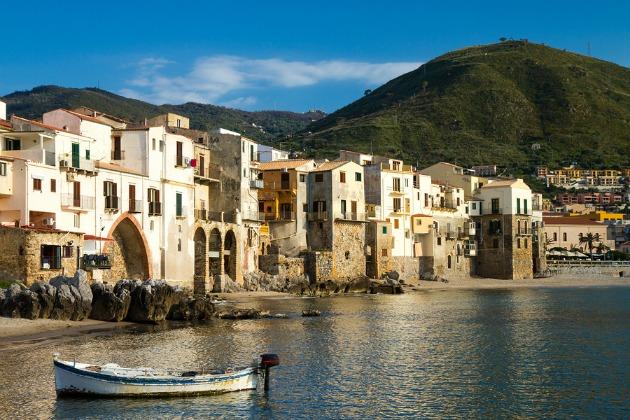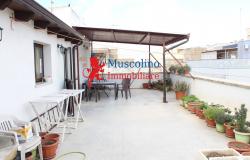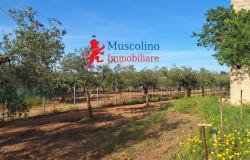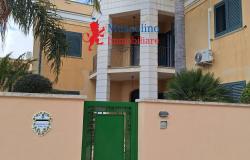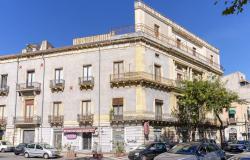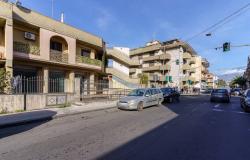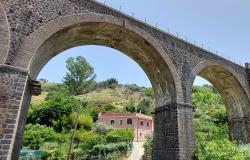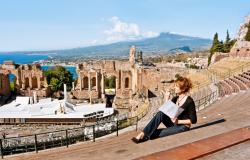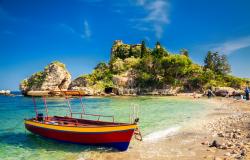The small town of Cefalù on Sicily‘s northern coast may not have the glitz and glamour of the island’s top resort, Taormina, but it has bucketfuls of atmosphere, charm – and sand! The town has featured in several Italian films, including the Oscar-winning Cinema Paradiso, and it’s easy to see why.
Its setting is spectacular. The ancient fishing port, dominated by its magnificent Norman cathedral, huddles below the mighty Rocca, a huge limestone crag from whose summit you can enjoy breathtaking panoramic views stretching as far as Palermo, some 50 miles to the west.
The beautiful, crescent-shaped beach offers safe, warm swimming in the Tyrrhenian Sea well into October or November. The beach is fringed by wooded mountains, and just a few miles inland lies the wonderful Madonie natural park, incorporating historic villages, abundant wildlife and some of the highest mountains in Sicily.
The beaches are jam-packed, and temperatures can rise up into the 40s. It’s far better to come during spring, when the hillsides are a riot of flowers, or autumn, when you will often be greeted with warm, sunny weather, and crowd-free sands.

Glory Days
The town’s heyday came after the Normans captured the town in 1064. Roger II commissioned the building of a great cathedral in 1131, apparently to give thanks for surviving a violent storm off the coast of Cefalù.
Inside it houses one of Sicily’s greatest art treasures – breathtaking mosaics depicting The Christ Pantokrator (all-mighty), above the Madonna, flanked by archangels, and below, two rows of Apostles. The mosaics, which predate those at Monreale (Palermo) by 40 years, portray Christ against a glittering gold background, his right hand in a gesture of benediction, his left holding an open bible.
His features – the elongated face and close-set eyes – are clearly Byzantine in style, but it is his sensitive, human expression which makes this 12th-century depiction so remarkable, and of international importance.
Adjoining the cathedral are the medieval cloisters, newly re-opened after restoration. Here, the Byzantine influence is also apparent in the paired columns carved with creatures such as lions and eagles.
If the Duomo dominates the town architecturally and spiritually, the vibrant Piazza Duomo below it is the hub of Cefalù‘s social life. Crowds gather here during the evening passeggiata to engage in animated discussion over a drink.
The popular Osteria del Duomo is a lovely spot in which to dine; its tables spread out over the cobbled square offer shade and respite at lunch-time, and a chance to watch the world pass by in the evening. The food and wine are excellent.
The town’s other historical sites include the medieval lavatoio, or wash-house, down near the tiny harbour. Here, steps lead down to stone-cut basins fed by a fresh-water spring which has been used since ancient times.

The town’s most stylish shops are in Corso Ruggero, while the parallel Via Vittorio Emanuele, which runs close to the sea, offers restaurants, bars, and numerous souvenir shops. Follow it down to the tiny fishing harbour, where you see colourful boats, and fishing nets laid out to dry.
From here, you can gaze back towards the shops and restaurants built into the town’s ancient walls which jut directly into the sea. Several of the restaurants along here offer terraces with spectacular coastal views.
Turning westwards from the fishing harbour, Via Vittorio Emanuele leads on to the spacious and very pleasant esplanade, or Lungomare, which runs the length of the curving beach. The blocks behind the promenade form part of the new town, and it is here you will find Cefalù‘s two modest supermarkets.
What to do in Cefalù
-
Mandralisca museum: it hosts the famous Portrait of an Unknown Man, painted in 1465 by Antonello da Messina. The smile of the sitter is said by some to be every bit as enigmatic and intriguing as that of the Mona Lisa. The collection, donated to the town by the collector Baron Enrico Piraino di Mandralisca, contains a host of eclectic treasures, including a Greek vase from the 4th century BC, depicting an argument between a tuna seller and his customer, and a display of 20,000 shells.
-
Opera dei Pupi: visit the Puppet theatre on Corso Ruggero where the Cuticchio family till perform traditional puppet shows which tell stories of Sicilian folklore, and battles between the Normans and the Saracens. The wooden, hand-carved puppets are nearly 3ft high, and the battle scenes in particular, in which they fight with swords and are adorned in glittering armour, are spectacular.
The Teatro Arte Cuticchio also includes a fascinating puppet museum telling the history of this Unesco-recognised art form. -
the Saturday market: where you will find an exotic array of fruit, vegetables, olives and cheeses.
-
the ascent of the 278m Rocca: it was here that the population fled to escape Saracen raids in ancient times, and you will find Arab and medieval fortifications during the climb, as well as the 5th-century so-called Tempio di Diana.
You can start the climb in the Piazza Garibaldi. Once you reached the summit – it takes 40 minutes or so – you can gaze along the coastline as far as Palermo in the west, and the Capo d’Orlando in the east.
Trips in the surroundings
Cefalù has an excellent transport connections and there are many possibilities for excursions.
-
Palermo: trains are frequent and cheap. You can reach the capital in less than one hour.
-
The Natural Park of Madonie with many historic towns and villages to explore, such as Castelbuono, with its impressive castle. Gibilmanna also offers panoramic views, but many Italians come here in pilgrimage to pray at the Baroque Santuario di Gibilmanna, where the Virgin is said to have performed miraculous deeds.
